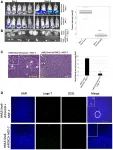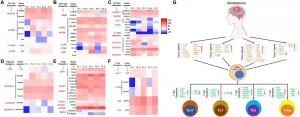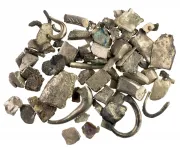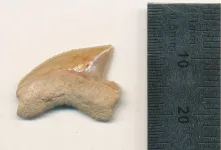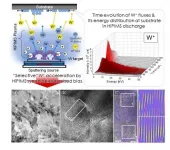(Press-News.org) Flies have discriminating taste. Like a gourmet perusing a menu, they spend much of their time seeking sweet nutritious calories and avoiding bitter, potentially toxic food. But what happens in their brains when they make these food choices?
Yale researchers discovered an interesting way to find out. They tricked them.
In a study that could also help illuminate how people make food choices, the researchers gave hungry fruit flies the choice between sweet, nutritious food laced with bitter quinine and a less sweet, but not bitter, food containing fewer calories. Then, using neuroimaging, they tracked neural activity in their brains as they made these tough choices.
So which won? Calories or better taste?
"It depends on how hungry they are," said Michael Nitabach, professor of cellular and molecular physiology, genetics, and neuroscience at Yale School of Medicine and senior author of the study. "The hungrier they are, the more likely they will tolerate bitter taste to obtain more calories."
But the real answer to how flies make these decisions is a little more complex, according to the study published July 5 in the journal Nature Communications.
According to the research team, led by Preeti Sareen, associate research scientist at Yale, flies relay sensory information to a portion of their brain called the fan-shaped body, where signals are integrated, triggering what amounts to the insect version of an executive decision. The researchers found that patterns of neuronal activity in the fan-shaped body change adaptively when novel food choices are introduced, which dictates the fly's decision over what food to eat.
But researchers went a step further. And things got even stranger. They found they could change a fly's choice by manipulating neurons in areas of the brain that feed into the fan-shaped body. For example, when they caused a decrease in activity in the neurons involved in metabolism, the found that it made hungry flies choose the lower calorie food.
"It is one big feedback loop, not just top-down decision making," Nitabach said.
And this is where there are connections to food choices of humans, he said. Neural activity in both a fly's brain and a human's brain are regulated by the secretion of neuropeptides and the neurotransmitter dopamine, which in humans helps regulate sensations of reward. Changes in this network may alter how the brain responds to different types of food. In other words, neurochemistry may sometimes dictate food choices we think we are making consciously.
"The study provides a template to understand how it is that things like hunger and internal emotional states influence our behavior," Nitabach said.
Sareen and Li Yan McCurdy, a graduate student at Yale School of Medicine, are co-authors of the paper.
INFORMATION:
Researchers at Uppsala University have discovered lymph node-like structures close to the tumour in brain cancer patients, where immune cells can be activated to attack the tumour. They also found that immunotherapy enhanced the formation of these structures in a mouse model. This discovery suggests new opportunities to regulate the anti-tumour response of the immune system.
Glioma is a deadly brain tumour with a dismal prognosis. One reason why brain tumours are very hard to treat is that our immune system, which is designed to detect and destroy foreign ...
Although most Canadians die from predictable causes and have health needs that can be met at home, only 20% of people receive a physician home visit in their last year of life.
To help understand the changing care needs of older adults as they age and when they might be nearing the end of their lives, a team of researchers developed the Risk Evaluation for Support: Predictions for Elder-Life in the Community Tool (RESPECT).
The calculator, which predicts death within 6 months, is based on data from more than 491 000 community-dwelling older adults who used home care in the 6-year period between 2007 and 2013.
"The RESPECT calculator allows families and their loved ...
Oncotarget published "Carcinoma cells that have undergone an epithelial-mesenchymal transition differentiate into endothelial cells and contribute to tumor growth" which reported that the authors investigated whether EMT can confer endothelial attributes upon carcinoma cells, augmenting tumor growth and vascularization.
Hypoxic regions, demarcated by HIF-1α staining, exhibited focal areas of E-cadherin loss and elevated levels of vimentin and the EMT-mediator FOXC2. Implantation of MCF-7 cells, co-mixed with human mammary epithelial cells overexpressing the EMT-inducer Snail, markedly ...
Oncotarget published "Perioperative changes in the plasma metabolome of patients receiving general anesthesia for pancreatic cancer surgery" which reported that little is known about the impact of anesthesia on the plasma metabolome, although many metabolites have been shown to modulate the function of various immune cells, making it particularly interesting in the context of oncological surgery.
In this study longitudinal dynamics in the plasma metabolome during general anesthesia in patients undergoing pancreatic surgery were analyzed.
Prospective, observational study with 10 patients diagnosed with pancreatic malignancy and subjected to elective resection surgery under general anesthesia.
Plasma metabolites were quantified at ...
Oncotarget published "Genome wide DNA methylation landscape reveals glioblastoma's influence on epigenetic changes in tumor infiltrating CD4+ T cells" which reported that whole-genome bisulfite sequencing of tumor infiltrating and blood CD4 T-cell from GBM patients showed 13571 differentially methylated regions and a distinct methylation pattern of methylation of tumor infiltrating CD4 T-cells with significant inter-patient variability.
The methylation changes also resulted in transcriptomic changes with 341 differentially expressed genes in CD4 tumor infiltrating T-cells compared to blood.
Analysis of specific genes involved in CD4 differentiation and function revealed differential methylation status of TBX21, GATA3, RORC, FOXP3, IL10 and ...
Inadequate exposure to UVB light from the sun may be associated with an increased risk of colorectal cancer, particularly in older age groups, according to a study using data on 186 countries, published in the open access journal BMC Public Health.
Researchers at the University of California San Diego, USA investigated possible associations between global levels of UVB light in 2017 and rates of colorectal cancer for different countries and age groups in 2018.
The authors found that lower UVB exposure was significantly correlated with higher rates of colorectal cancer across all ...
Why are gold deposits found at all? Gold is famously unreactive, and there seems to be little reason why gold should be concentrated, rather than uniformly scattered throughout the Earth's crust. Now an international group of geochemists have discovered why gold is concentrated alongside arsenic, explaining the formation of most gold deposits. This may also explain why many gold miners and others have been at risk from arsenic poisoning. This work is presented at the Goldschmidt conference, after recent publication*.
Gold has been prized for millennia, for its purity and stability. It's also rare enough to retain its value - the World Gold Council estimates that all the gold ever mined in the world would fit into a 20x20x20-meter cube. It is valued for its beauty, but also because it ...
Scientists have reconstructed the Eastern Mediterranean silver trade, over a period including the traditional dates of the Trojan War, the founding of Rome, and the destruction of Solomon's Temple in Jerusalem. The team of French, Israeli and Australian scientists and numismatists found geochemical evidence for pre-coinage silver trade continuing throughout the Mediterranean during the Late Bronze and Iron Age periods, with the supply slowing only occasionally. Silver was sourced from the whole north-eastern Mediterranean, and as far away as the Iberian ...
Scientists have found an unexplained cache of fossilised shark teeth in an area where there should be none - in a 2900 year old site in the City of David in Jerusalem. This is at least 80 km from where these fossils would be expected to be found. There is no conclusive proof of why the cache was assembled, but it may be that the 80 million-year-old teeth were part of a collection, dating from just after the death of King Solomon*. The same team has now unearthed similar unexplained finds in other parts of ancient Judea.
Presenting the work at the Goldschmidt Conference, lead researcher, Dr. Thomas Tuetken (University of Mainz, Institute of Geosciences) said:
"These fossils are not in their original setting, so they have been moved. They were probably valuable to someone; ...
Tokyo, Japan - Researchers from Tokyo Metropolitan University have used high power impulse magnetron scattering (HiPIMS) to create thin films of tungsten with unprecedentedly low levels of film stress. By optimizing the timing of a "substrate bias pulse" with microsecond precision, they minimized impurities and defects to form crystalline films with stresses as low as 0.03 GPa, similar to those achieved through annealing. Their work promises efficient pathways for creating metallic films for the electronics industry.
Modern electronics relies on the intricate, nanoscale deposition of thin metallic films onto surfaces. This is easier said than done; unless done right, "film stresses" arising from the microscopic internal structure of the film ...
